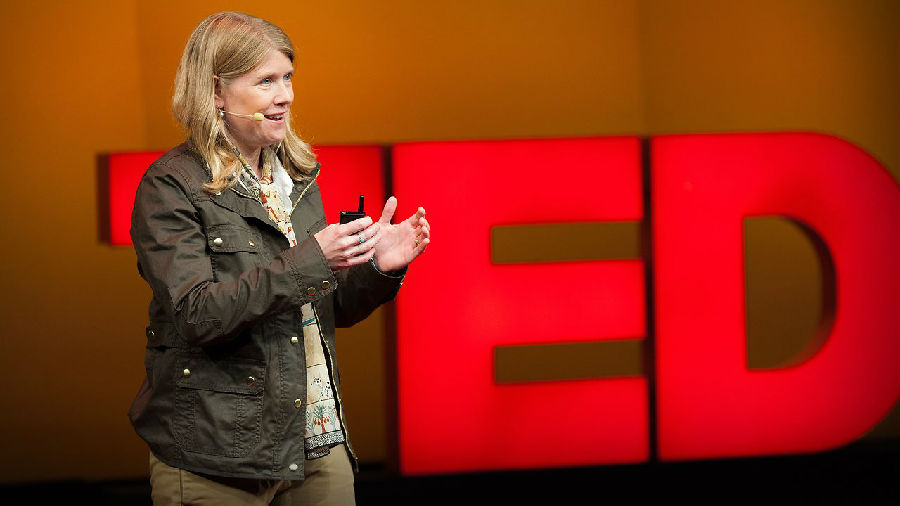(单词翻译:单击)
When I was a child growing up in Maine, one of my favorite things to do was to look for sand dollars on the seashores of Maine,
我从小在缅因州长大,儿时我最爱做的一件事就是到海边捡拾沙钱。
because my parents told me it would bring me luck. But you know, these shells, they're hard to find.
因为我爸妈说捡拾它们会带来好运。但想也知道这些贝壳很难找。
They're covered in sand, they're difficult to see. However, over time, I got used to looking for them.
它们被埋在沙子里,很难发现。无论如何,久而久之我就抓到诀窍了。
I started seeing shapes and patterns that helped me to collect them.
我开始依据它们的形状和图案,帮助我找寻沙钱。
This grew into a passion for finding things, a love for the past and archaeology.
我对寻宝的热爱也就此产生了,我迷上了与过去有关的事物和考古学。
And eventually, when I started studying Egyptology, I realized that seeing with my naked eyes alone wasn't enough.
终于,在我开始研究埃及古物学后,我发现光用肉眼探寻是不够的。
Because all of the sudden, in Egypt, my beach had grown from a tiny beach in Maine to one eight hundred miles long, next to the Nile.
因为在埃及,我眼中的沙滩忽然间从缅因州的小沙滩变成了一条八百英里长、紧邻尼罗河的沙滩。
And my sand dollars had grown to the size of cities. This is really what brought me to using satellite imagery.
而我的沙钱也变得和城市一样巨大。就是因为这样,我才开始使用卫星影像。
For trying to map the past, I knew that I had to see differently.
如果想把过去完整的呈现出来,我就得从不同的角度看事情。
So I want to show you an example of how we see differently using the infrared.
所以我想举个例子,让各位知道我们是如何用红外线来进行另类观测的。
This is a site located in the eastern Egyptian delta called Mendes.
这是尼罗河三角洲东部的邦狄克斯。
And the site visibly appears brown, but when we use the infrared and we process it,
这个地点看起来呈现褐色,但如果我们用红外线加工处理,
all of the sudden, using false color, the site appears as bright pink.
并加上假色影像,这个地点瞬间变成了亮粉色。
What you are seeing are the actual chemical changes to the landscape caused by the building materials and activities of the ancient Egyptians.
你看到的其实是古埃及人的建筑施工的材料对地面产生的化学影响。
What I want to share with you today is how we've used satellite data to find an ancient Egyptian city, called Itjtawy, missing for thousands of years.
今天我想和各位分享的是我们如何通过卫星数据,找到一座消失了几千年、叫做伊塔威的埃及古城。
Itjtawy was ancient Egypt's capital for over four hundred years, at a period of time called the Middle Kingdom, about four thousand years ago.
伊塔威曾是古埃及的首都,长达超过四百年之久,这段时间大约在四千多年前古埃及的中王国时期。
The site is located in the Faiyum of Egypt, and the site is really important,
伊塔威的地点位于埃及的法尤姆市,它的位置非常重要,
because in the Middle Kingdom there was this great renaissance for ancient Egyptian art, architecture and religion.
因为在中王国时期,曾有一次涉及艺术、建筑和宗教层面的伟大的古埃及文艺复兴。
Egyptologists have always known the site of Itjtawy was located somewhere near the pyramids of the two kings who built it,
埃及学家早就知道伊塔威的大概位置约莫位于某两任法老所建的金字塔群附近,
indicated within the red circles here, but somewhere within this massive flood plain.
也就是图中的红色圈圈里,在这广大冲积平原中的某处。
This area is huge -- it's four miles by three miles in size.
这个区域非常的宽广,长为四英里,宽为三英里。
The Nile used to flow right next to the city of Itjtawy,
尼罗河曾在伊塔威周围流过,
and as it shifted and changed and moved over time to the east, it covered over the city.
随着河道变化,河流渐渐的向东移动,最终覆盖了这座城市。
So, how do you find a buried city in a vast landscape?
我们该如何在宽广的平原中寻找一座埋藏在地底的城市呢?

Finding it randomly would be the equivalent of locating a needle in a haystack, blindfolded, wearing baseball mitts.
漫无目的的寻找只会像大海捞针一样不切实际。
So what we did is we used NASA topography data to map out the landscape, very subtle changes.
因此我们使用美国国家航空航天局的地形数据,来绘出地表景物上极细微的变化。
We started to be able to see where the Nile used to flow.
我们可以看到尼罗河曾经流过的地方。
But you can see in more detail, and even more interesting,
你会发现更多的细节,更有趣的是,
this very slight raised area seen within the circle up here which we thought could possibly be the location of the city of Itjtawy.
红色圈圈中这个微微高起的区域,很有可能是伊塔威的所在位置。
So we collaborated with Egyptian scientists to do coring work, which you see here.
于是我们和埃及科学家合作进行岩层采样,就像这张图。
When I say coring, it's like ice coring, but instead of layers of climate change, you're looking for layers of human occupation.
岩层采样就像研究不同时期气候变迁的冰层采样,只是我们关注的是岩层中人类活动的遗迹。
And, five meters down, underneath a thick layer of mud, we found a dense layer of pottery.
向下延伸五公尺,在一层厚厚的泥浆下,我们找到了一层包含大量陶器的岩层。
What this shows is that at this possible location of Itjtawy, five meters down, we have a layer of occupation for several hundred years,
这表示此地可能是伊塔威的所在位置,往地下延伸五公尺的地方,我们找到了这片藏有数百年前人类活动遗迹的岩层,
dating to the Middle Kingdom, dating to the exact period of time we think Itjtawy is.
时间可追溯到中王国时期,那是伊塔威存在的确切时间。
We also found work stone -- carnelian, quartz and agate that shows that there was a jeweler's workshop here.
同时我们也找到了工艺石材--光玉髓、水晶和玛瑙,显示这里曾经有一间珠宝工坊。
These might not look like much, but when you think about the most common stones used in jewelry from the Middle Kingdom,
这些可能看起来很普通,但比较一下中王国时期珠宝最常用的石料,
these are the stones that were used.
这就是那些最常见的石料。
So, we have a dense layer of occupation dating to the Middle Kingdom at this site.
现在我们有了一片富藏人类遗迹的岩层,它的年代追溯到了中王国时期。
We also have evidence of an elite jeweler's workshop, showing that whatever was there was a very important city.
我们同样有一座名贵珠宝作坊的证据,这表明这里曾经存在着一座非常重要的城市。
No Itjtawy was here yet, but we're going to be returning to the site in the near future to map it out.
这里还不一定是伊塔威,但我们近期内将会回到那里去进行绘图。
And even more importantly, we have funding to train young Egyptians in the use of satellite technology
更重要的是,我们筹资训练年轻的埃及人使用卫星技术,
so they can be the ones making great discoveries as well.
这样他们自己也能够做出这些重要发现了。
So I wanted to end with my favorite quote from the Middle Kingdom
最后,我想用我最爱的名言来结束我的演讲,这句话来自古埃及中王国时代
it was probably written at the city of Itjtawy four thousand years ago.
很可能是在4000年前在伊塔威写下的。
"Sharing knowledge is the greatest of all callings. There's nothing like it in the land."
“分享知识是最伟大的使命。世间没有其他事可以与之相提并论。”
So as it turns out, TED was not founded in 1984 AD.
结果你发觉,TED并不是公元1984年建立的。
Making ideas actually started in 1984 BC at a not-lost-for-long city, found from above.
这个想法其实是从公元前1984年,从一座“失落了没多久”,又这样被找到的古城开始的。
It certainly puts finding seashells by the seashore in perspective. Thank you very much. Thank you.
这也让人们对找贝壳这事有了新的理解。非常感谢。谢谢。


